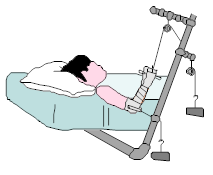There are many essential concepts of tractions. Here are the essential guidelines to be remembered:
T : trapeze bar over head is used to raise and lower the upper body
R : requires free hanging weights
A : analgesic to relieve pain
C : check circulation
T : temperature monitoring
I : infection prevention
O : output and intake monitoring
N : nutrition in appropriate diet
S : skin check frequently
Here are the tractions most questioned on exams:
BRYANT'S TRACTION
It is used to reduce femoral fracture in children. The buttocks are slightly elevated and clear off the bed. Position is on flat.
BUCK'S TRACTION
It is used to reduce femoral fracture in children. Nurse should periodically assess skin status. Skin should be clean and dry. Position is on flat or trendelenburg.
CRUTCHFIELD TONG
It is used to immobilize the cervical spine. The X-ray may be taken to verify the placement. Encourage to massage occiput.
DUNLOP'S TRACTION
Dunlop's traction includes horizontal and vertical tractions. Horizontal traction is used to align fracture of the humerus. Vertical traction is used to maintain proper alignment of forearm. Nurse should assess for skin breakdown and signs of circulatory impairment and nerve damage, and make sure that the weight is hanged freely.
HALO VEST It is used to immobilize the cervical spine. When caring client with halo vest the nurse should:
- avoid putting powder inside the vest
- turn the client as a unit (do not use the halo vest to lift the client)
- assess for signs of shoulder stress or pressure ulcer
PELVIC TRACTION
It is used to relieve back pain. The client is position in which the head of the bed is slightly elevated.
RUSSELL'S TRACTION
It is used to immobilize the hip or knees or to reduce fracture. The heel of the client should be off the bed.









0 comments
Post a Comment